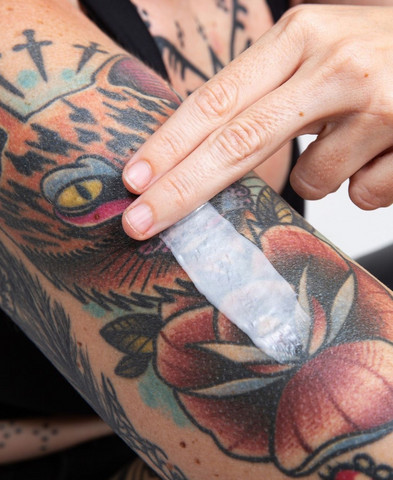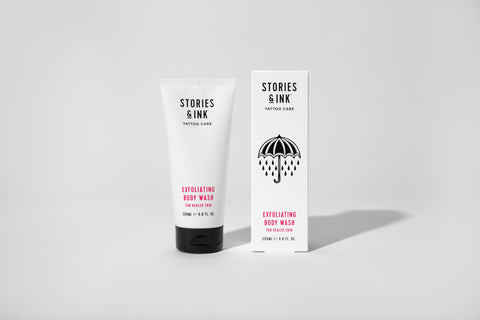Can You Exfoliate A Tattoo? Yes, you can exfoliate a tattoo to remove dead skin cells, brighten the ink, and improve its overall appearance, but it’s crucial to wait until the tattoo is fully healed before exfoliating. At tattooat.com, we will explore the best practices for tattoo aftercare, including when and how to exfoliate safely to maintain your body art looking its best by using the right exfoliation techniques and tattoo skincare products. Keep reading to know when to start exfoliating your tattooed skin.
1. Why Exfoliate Tattoos? Understanding the Benefits
Exfoliating tattoos offers numerous benefits, including brighter and clearer ink, so it is important to know how to do it right. Exfoliation removes dead skin cells, promotes blood circulation, and enhances the vibrancy of your body art.
1.1. Shedding Light on Skin Cell Turnover
Humans shed approximately 200 million skin cells every hour, according to a study. However, not all these cells shed completely, which leads to dead skin accumulating, causing dryness, dullness, and clogged pores. Exfoliation helps to shed and remove dead skin.
1.2. The Impact of Exfoliation
Exfoliation makes your skin smooth, and it allows moisturizers to penetrate deeply, keeping your tattoos vibrant. Remember that using the correct exfoliation techniques helps maintain healthy skin.
2. How to Exfoliate Tattoos Effectively
 Woman using exfoliating body wash in the shower
Woman using exfoliating body wash in the shower
Effective exfoliation of tattoos involves understanding your skin type and using gentle methods to avoid irritation. Remember, tattoos require care.
2.1. Identifying Your Skin Type
The American Academy of Dermatology Association provides guidelines for different skin types:
| Skin Type | Characteristics |
|---|---|
| Sensitive Skin | Stings or burns after product use |
| Normal Skin | Clear and not sensitive |
| Dry Skin | Flaky, itchy, or rough |
| Oily Skin | Shiny and greasy |
| Combination Skin | Dry in some areas and oily in others |
2.2. Gentle Exfoliation Techniques
Regardless of your skin type, it is essential to exfoliate gently, especially on recently tattooed skin.
2.3. Best Practices for Exfoliating
Here are some best practices for exfoliating tattoos:
- Apply the exfoliating product to your skin while showering.
- Use gentle, circular motions.
- Rinse thoroughly after scrubbing.
- Use exfoliators twice a week to avoid removing natural oils or causing dryness.
3. When Can You Exfoliate a New Tattoo?
It’s generally safe to begin exfoliating only after the tattoo is completely healed. This process can take anywhere from two to four weeks, or even longer.
3.1. The Tattoo Healing Process
Avoid injuring your tattoo during healing to prevent infections or ink disturbances. Washing the area gently two or three times daily and applying a thin coat of lotion-based care product is essential. Consider using Stories & Ink’s tattoo Aftercare Cream.
3.2. Sun Protection
According to the National Center for Biotechnology Information (NCBI), it is important to avoid sun exposure to reduce the risk of skin barrier dysfunction, abnormal skin pigmentation, fading, or cracking of the tattoo. Sunbeds and artificial tanning methods should also be avoided.
4. Can I Exfoliate a Tattoo After 1 Month?
After one month, a gentle exfoliating product like Stories & Ink’s Exfoliating Body Wash can be used if the tattoo appears healed. However, because complete healing can take up to three months, being gentle is advisable.
5. Can I Pick Dead Skin Off Tattoos?
Never pick dead skin off new tattoos. Exfoliating or picking at a fresh tattoo can lead to infection or scarring, which can spoil the tattoo’s appearance. It’s best to follow the aftercare guidelines provided by your artist and let nature take its course.
 Peeling tattoo on arm
Peeling tattoo on arm
6. Is It Normal for Tattoos to Peel?
It’s completely normal for new tattoos to peel as part of the healing process. Most tattoos peel by the end of their first week, and scabs may form and peel during the second week.
6.1. Factors Influencing Peeling
The amount of dead skin on your new tattoos can depend on:
- The size of the tattoo
- How well it is moisturized
- Its location on the body
6.2. Tattoos on Mobile Areas
Tattoos located on areas like elbows, hands, or feet may take longer to peel due to increased movement.
7. Tattoo Peeling: No Ink Underneath
It’s normal for some ink to come away during the peeling process, as some ink remains on the skin’s surface or collects in scabs. As your body repairs itself, this excess ink naturally sheds.
7.1. Proper Aftercare
To ensure proper healing, follow your tattoo aftercare regime, which includes:
- Blotting tattoos dry with a towel instead of rubbing.
- Wearing loose clothing.
- Keeping the tattoo moisturized.
- Avoiding picking at the peeling skin.
8. My Peeling Tattoo Looks Faded
A peeling tattoo may appear faded or dull due to a layer of dead skin cells forming on top. Once this layer sheds, the colors should regain their vibrancy.
8.1. When to Seek Medical Advice
Excessive peeling combined with redness, swelling, or itching could indicate an infection. Seek medical advice if you have concerns.
9. Can You Exfoliate a Tattoo Away?
Exfoliating a healed tattoo will not remove the ink. Exfoliation only removes the top layer of skin, while tattoo ink is deposited deeper into the dermis. Over time, tattoos may fade, especially without proper care.
10. Best Tattoo Exfoliators
 Stories & Ink Exfoliating Body Wash
Stories & Ink Exfoliating Body Wash
Choosing the right exfoliating product is crucial. Opt for products made specifically for tattooed skin, like Stories & Ink’s Exfoliating Body Wash.
10.1. Key Ingredients and Benefits
Stories & Ink’s Exfoliating Body Wash contains natural fruit extracts that gently exfoliate dead skin cells, revealing brighter tattoos. It also includes red algae extract, which tones the skin and provides a luminous complexion.
10.2. Additional Advantages
Further advantages of tattoo exfoliating body wash:
- Vegan
- Cruelty-free
- Gluten-free
The use of natural alternatives to microplastic beads makes it non-irritating and environmentally friendly. Its gentleness makes it ideal for daily use, ensuring your skin and tattoos look their best.
11. Understanding the Science Behind Tattoo Fading
To further understand how exfoliation fits into tattoo aftercare, it’s helpful to know why tattoos fade in the first place. Several factors contribute to this:
- Sun Exposure: UV rays break down the ink particles.
- Natural Skin Turnover: Over time, the body’s natural processes can cause ink to disperse.
- Poor Ink Quality: Lower-quality inks fade faster.
- Tattoo Placement: Areas with more friction (like fingers or feet) tend to fade quicker.
11.1. The Role of the Dermis
Tattoo ink is injected into the dermis layer of the skin, which is more stable than the epidermis (the outer layer). However, the dermis still undergoes changes over time, leading to gradual fading.
11.2. How Exfoliation Helps
Exfoliation primarily addresses the epidermis. By removing dead skin cells, it helps to keep the surface of the tattoo clear and vibrant. It does not prevent fading in the dermis but enhances the tattoo’s appearance by ensuring the top layer of skin is healthy and smooth.
12. Debunking Tattoo Exfoliation Myths
There are several myths about exfoliating tattoos that need clarification:
- Myth 1: Exfoliating will remove my tattoo. As mentioned, exfoliation only affects the epidermis, not the dermis where the ink resides.
- Myth 2: All scrubs are safe for tattoos. Harsh scrubs can irritate the skin and damage a healing tattoo. Gentle, tattoo-specific exfoliators are best.
- Myth 3: You should exfoliate a new tattoo to help it peel. Exfoliating a new tattoo can cause serious damage and increase the risk of infection.
- Myth 4: Exfoliating makes tattoos heal faster. Exfoliation is not part of the initial healing process and should only be done on fully healed tattoos.
13. The Importance of Moisturizing After Exfoliating
After exfoliating, moisturizing is crucial. Exfoliation can sometimes dry out the skin, so replenishing moisture helps keep the skin healthy and the tattoo vibrant.
13.1. Choosing the Right Moisturizer
Look for moisturizers that are:
- Fragrance-free
- Alcohol-free
- Hypoallergenic
These qualities reduce the risk of irritation. Products containing natural ingredients like shea butter, cocoa butter, and vitamin E are excellent choices.
13.2. How to Moisturize
Apply a thin layer of moisturizer to the exfoliated area. Gently massage it into the skin until fully absorbed. Do this once or twice a day, or as needed, to maintain skin hydration.
14. How to Choose the Right Exfoliating Product for Your Tattoo
Selecting the appropriate exfoliating product is vital to avoid damaging your tattoo. Here are some factors to consider:
- Ingredients: Opt for products with natural exfoliating agents like fruit enzymes or algae extract. Avoid harsh chemicals and artificial fragrances.
- Skin Type: Choose products formulated for your skin type (sensitive, oily, dry, or combination).
- Texture: A gentle, creamy texture is preferable to coarse, abrasive scrubs.
- Reviews: Read reviews from other tattoo enthusiasts to gauge the product’s effectiveness and safety.
14.1. DIY Exfoliating Options
If you prefer a natural approach, you can create your own exfoliating mixtures. Here are a couple of simple recipes:
- Oatmeal Scrub: Mix finely ground oatmeal with honey and a touch of water. Gently massage onto the skin and rinse.
- Sugar Scrub: Combine fine sugar with olive oil or coconut oil. Use gentle circular motions and rinse thoroughly.
Always test a small area first to ensure you don’t have an adverse reaction.
15. What Professionals Say About Tattoo Exfoliation
According to Inked Magazine, tattoo artists recommend waiting until the tattoo is fully healed before exfoliating. They also emphasize the importance of using gentle products and techniques to avoid damaging the ink.
15.1. Expert Tips for Tattoo Care
Here are some expert tips for tattoo care:
- Follow Aftercare Instructions: Adhere to the specific instructions provided by your tattoo artist.
- Stay Hydrated: Drinking plenty of water keeps your skin healthy and hydrated.
- Avoid Tight Clothing: Wear loose clothing to prevent friction and irritation.
- Protect from the Sun: Use sunscreen with a high SPF to protect your tattoo from UV rays.
16. Tattoo Aftercare: A Comprehensive Guide
Proper tattoo aftercare is vital for maintaining the vibrancy and health of your tattoos. Here’s a comprehensive guide to ensure your tattoos remain in excellent condition:
| Step | Description | Timing |
|---|---|---|
| Cleaning | Gently wash the tattoo with mild, fragrance-free soap and warm water. | 2-3 times daily during the initial healing phase |
| Drying | Pat the area dry with a clean paper towel. Avoid rubbing. | After each cleaning |
| Moisturizing | Apply a thin layer of tattoo-specific moisturizer or a fragrance-free, hypoallergenic lotion. | After drying and as needed to keep the skin hydrated |
| Protecting from the Sun | Apply a broad-spectrum sunscreen with an SPF of 30 or higher. | Daily, especially when exposed to sunlight |
| Avoiding Irritants | Avoid tight clothing, harsh chemicals, and prolonged water immersion. | Throughout the healing process and beyond |
| Exfoliating | Gently exfoliate with a tattoo-safe product. | Only after the tattoo is fully healed |
| Staying Hydrated | Drink plenty of water to keep your skin hydrated from the inside out. | Daily |
| Regular Check-Ups | Monitor your tattoo for any signs of infection or complications. Seek professional advice if needed. | Throughout the healing process and periodically thereafter |
17. Common Tattoo Healing Problems and Solutions
Even with the best care, some issues may arise during tattoo healing. Here are common problems and how to address them:
| Problem | Symptoms | Solution |
|---|---|---|
| Infection | Redness, swelling, pain, pus, fever | Seek medical attention immediately. Follow the doctor’s instructions for antibiotics and wound care. |
| Allergic Reaction | Itching, rash, hives | Use an antihistamine to relieve itching. If symptoms persist, consult a doctor. |
| Keloids | Raised, thick scar tissue | See a dermatologist for treatment options, such as steroid injections or laser therapy. |
| Fading | Loss of ink vibrancy | Protect the tattoo from sun exposure with sunscreen. Consider a tattoo touch-up to restore color. |
| Dryness | Flaky, itchy skin | Moisturize regularly with a tattoo-safe lotion. Avoid products with alcohol or fragrance. |
| Excessive Peeling | Large amounts of skin peeling off | Ensure you’re not over-moisturizing or exfoliating too early. Allow the skin to heal naturally. |
| Sunburn | Red, painful, blistered skin | Apply cool compresses and aloe vera to soothe the skin. Avoid further sun exposure and keep the area moisturized. |
| Scarring | Permanent marks on the skin | Consult a dermatologist for treatment options, such as silicone sheets or laser therapy. |
| Ink Bleeding | Ink spreading beyond the tattoo’s outline | This can be caused by poor tattooing technique or improper aftercare. Consult your tattoo artist or a dermatologist for advice. |
| Bumps or Pimples | Small, raised bumps around the tattoo | These can be caused by irritation or clogged pores. Keep the area clean and avoid picking at the bumps. If they persist, consult a dermatologist. |
18. The Future of Tattoo Aftercare
The tattoo industry is continuously evolving, with new products and techniques emerging to improve tattoo aftercare. Some exciting developments include:
- Advanced Healing Balms: Formulations with growth factors and stem cell activators to promote faster healing.
- Smart Bandages: Bandages that monitor the tattoo’s temperature and moisture levels to optimize the healing environment.
- Laser-Assisted Healing: Using low-level laser therapy to reduce inflammation and accelerate healing.
- Biodegradable Inks: Inks made from natural, biodegradable materials that are less likely to cause allergic reactions and fade more evenly.
As research advances, tattoo aftercare will become more effective and convenient, ensuring tattoos remain vibrant and healthy for years to come.
19. Finding Inspiration and Resources at tattooat.com
At tattooat.com, we provide a wealth of resources to help you explore tattoo designs, find talented artists, and learn essential tattoo knowledge. Whether you are looking for inspiration or need guidance on aftercare, our site is your ultimate destination.
19.1. Discover Unique Tattoo Designs
Explore our extensive library of tattoo designs categorized by theme, style, and body placement. Find the perfect design that reflects your personality and style.
19.2. Connect with Talented Artists
Browse our curated list of talented tattoo artists across the United States. View their portfolios and find an artist whose style resonates with you.
19.3. Learn Essential Tattoo Knowledge
Access our detailed articles and guides on every aspect of tattooing, from preparation to aftercare. Make informed decisions and ensure your tattoos remain vibrant and healthy.
20. Frequently Asked Questions (FAQs) About Tattoo Exfoliation
Here are some frequently asked questions about exfoliating tattoos:
1. Can I use a regular body scrub on my tattoo?
It’s best to use a gentle exfoliator specifically designed for tattoos to avoid irritation.
2. How often should I exfoliate my tattoo?
Exfoliate about twice a week to avoid over-exfoliating and drying out the skin.
3. What are the signs of over-exfoliation?
Signs include redness, irritation, and excessive dryness.
4. Can I exfoliate a sunburned tattoo?
No, avoid exfoliating a sunburned tattoo as it can cause further damage.
5. Is it okay to use a chemical peel on my tattoo?
Chemical peels are generally too harsh for tattoos and should be avoided.
6. Can exfoliating help with tattoo fading?
Exfoliating can improve the appearance of a tattoo by removing dead skin cells, but it does not prevent fading in the dermis.
7. What ingredients should I avoid in an exfoliator for tattoos?
Avoid products with harsh chemicals, artificial fragrances, and alcohol.
8. Can I use a loofah to exfoliate my tattoo?
A gentle loofah can be used, but ensure it is clean and used with a gentle exfoliating cleanser.
9. How long after getting a tattoo can I start exfoliating?
Wait until the tattoo is fully healed, usually around 2-4 weeks.
10. Can I exfoliate if my tattoo is still raised?
No, wait until the tattoo is completely flat and smooth before exfoliating.
Conclusion
Can you exfoliate a tattoo? Yes, exfoliating tattoos is a great way to keep them looking vibrant, but patience and gentleness are key. By waiting until your tattoo is fully healed and using the right products, you can safely remove dead skin cells and enhance your ink’s appearance. Remember to moisturize afterward and protect your tattoos from the sun.
Ready to explore the world of tattoos? Visit tattooat.com today to discover unique designs, connect with talented artists, and learn everything you need to know about tattoo aftercare. Don’t wait—your perfect tattoo experience awaits. Contact us at Address: 1825 SW Broadway, Portland, OR 97201, United States or Phone: +1 (503) 725-3000.